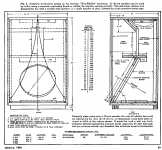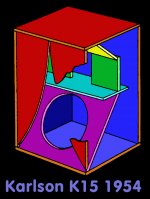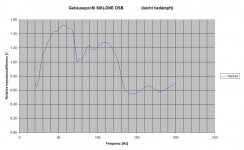Ernst Georg Beck is a member of the AES Society, seems he is more than a hobby-guy, since the linked article was published some time ago in a magazine and he published quite a lot constructions. See also Akustik, Lautsprecher, Boxen for more info about him
@sabbelbacke
Sorry, it was not my intent do diminish
Dr. Becks reputation.
I found the article some years ago and for me it
was a good introduction, describing the principle
and its application in a clear manner.
Kind Regards
Sorry, it was not my intent do diminish
Dr. Becks reputation.
I found the article some years ago and for me it
was a good introduction, describing the principle
and its application in a clear manner.
Kind Regards
I´ve used them (although not in the karlsons) all. You get what you pay for.. They are both not too expensive, but lose clearly when in competition to BMS, Beyma, 18Sound (which all are way more expensive). Frequency range, max SPL and distortion are superior in the more expensive types.
If 1kHz is enough and used @home, better go for a smaller driver. BMS4554 i.e. is not too expensive and sounds great. Of course, the 2" Eminence is more robust and can be driven down to 800Hz.
Hi Sabbelbacke
Thanks for the tip on the BMS 4554, are you using it at home ?
Did you figure out what Karlson you have there ?
The 15" Beyma SM115/N with 29 Hz res looks good for a 'K' or 'X'.
Check out the spec.
Cheers
😎
Simon
Simon
I am using many BMS drivers in Pro-Audio Cabs (also many others), the BMS I personally like very much for the typical sound caused by the construction type they have (backwards sonic guidance within the driver). It results in a little more K2 than other drivers while having less K3. I guess that´s why many like to use them in hifi, too.. The 4554 is very good sounding for a fair price and is able to deal with a low cut off while still having enough high-end for a 1,4" driver with a smooth roll off at around 20kHz.
Didn´t have time to play with the Karlsons..
Didn´t have time to play with the Karlsons..
I am using many BMS drivers in Pro-Audio Cabs (also many others), the BMS I personally like very much for the typical sound caused by the construction type they have (backwards sonic guidance within the driver). It results in a little more K2 than other drivers while having less K3. I guess that´s why many like to use them in hifi, too.. The 4554 is very good sounding for a fair price and is able to deal with a low cut off while still having enough high-end for a 1,4" driver with a smooth roll off at around 20kHz.
Didn´t have time to play with the Karlsons..
Hi Sabbelbacke
Thanks for the rec on the BMS4554
Cheers
Simon
😎
@sabbelbacke
Sorry, it was not my intent do diminish
Dr. Becks reputation.
I found the article some years ago and for me it
was a good introduction, describing the principle
and its application in a clear manner.
Kind Regards
Hi LineArray
Thanks for the article link.
There is an English translation of this article on the net.
Well worth checking out.
Dr. Beck's got some damn fine looking bass horn's to check out as well.
Do you do Karlson LineArray ?
Cheers
Simon
😎
...
Do you do Karlson LineArray ?
Cheers
Simon
😎
Not really, but i used "Carlsonification" of pipes
occasionally.
This one e.g. was a modification of a design by
Graham Maynard.
Attachments
-
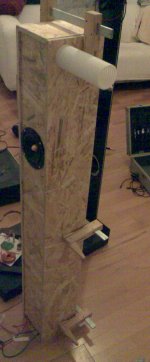 siklone_osb_proto_1.jpg120.9 KB · Views: 494
siklone_osb_proto_1.jpg120.9 KB · Views: 494 -
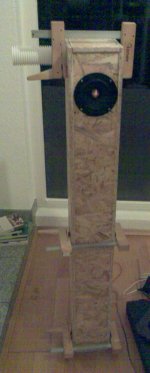 siklone_osb_proto_2.jpg117.5 KB · Views: 467
siklone_osb_proto_2.jpg117.5 KB · Views: 467 -
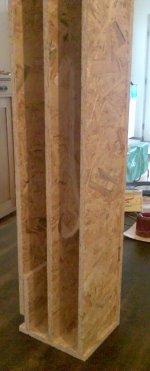 siklone_osb_proto_3.jpg113.5 KB · Views: 198
siklone_osb_proto_3.jpg113.5 KB · Views: 198 -
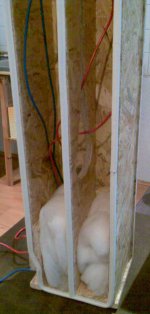 siklone_osb_proto_impedance_01_2.jpg118.4 KB · Views: 190
siklone_osb_proto_impedance_01_2.jpg118.4 KB · Views: 190 -
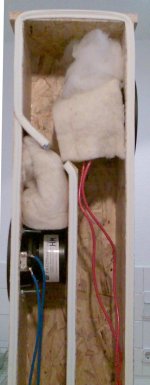 siklone_osb_proto_impedance_01_1.jpg87.3 KB · Views: 210
siklone_osb_proto_impedance_01_1.jpg87.3 KB · Views: 210 -
 siklone_osb_proto_4.jpg81.5 KB · Views: 207
siklone_osb_proto_4.jpg81.5 KB · Views: 207 -
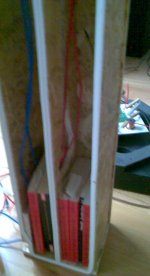 siklone_osb_proto_filled_bottom.jpg130.6 KB · Views: 170
siklone_osb_proto_filled_bottom.jpg130.6 KB · Views: 170
Last edited:
Not really, but i used "Carlsonification" of pipes
occasionally.
This one e.g. was a modification of a design by
Graham Maynard.
Hi LineArray
Thanks for the photos.
I looked at your site and enjoyed your thoughts there.
I can see the Karlson 'shape', 'slot' whatever, inside your speakers linking the 2 chambers.
Would you explain why you used this shape cut-out here. Why not a circle, square or any other shape.
I can't work out why the Karlson shape (It actualy looks like the shape of a falling drop of water in your photos)
Nice work !
Cheers
Simon
Last edited:
Hi Simon,
this enclosure has been developed in a rather
'non scientific way' let's say 'freestile acoustics' with
some educated guessing 😉
Goal was to have a fairly resistive load, when both
drivers wired in parallel are seen as one 'unit',
and the slot was introduced mainly to supress higher
order modes of the pipe, which is excited at both ends
with the drivers operating in phase.
There is a resistive slot between the drivers in the top
section as well and a port, which is attached to the
- somewhat larger - rear chamber of the 'front' driver.
1. Attached picture shows the impedance of both drivers
in free air (pink), and builtin to the enclosure (blue).
2. (ZfreeAir - Rg) / (Zbuiltin - Rg)
Kind of "impedance ratio" using only the magnitude of
builtin and free air impedance.
As can be seen, the enclosure reduces electrical impedance
- and thus average voice coil velocity and excursion of both
drivers- even as low as 30Hz.
I haven't measured nearfield frequency response at that time
playing around with it, but it goes significantly lower than
40Hz using two FR 125s drivers.
As far as i remember there was only the stuffing shown in the
pics - near the drivers - during impedance measurement.
this enclosure has been developed in a rather
'non scientific way' let's say 'freestile acoustics' with
some educated guessing 😉
Goal was to have a fairly resistive load, when both
drivers wired in parallel are seen as one 'unit',
and the slot was introduced mainly to supress higher
order modes of the pipe, which is excited at both ends
with the drivers operating in phase.
There is a resistive slot between the drivers in the top
section as well and a port, which is attached to the
- somewhat larger - rear chamber of the 'front' driver.
1. Attached picture shows the impedance of both drivers
in free air (pink), and builtin to the enclosure (blue).
2. (ZfreeAir - Rg) / (Zbuiltin - Rg)
Kind of "impedance ratio" using only the magnitude of
builtin and free air impedance.
As can be seen, the enclosure reduces electrical impedance
- and thus average voice coil velocity and excursion of both
drivers- even as low as 30Hz.
I haven't measured nearfield frequency response at that time
playing around with it, but it goes significantly lower than
40Hz using two FR 125s drivers.
As far as i remember there was only the stuffing shown in the
pics - near the drivers - during impedance measurement.
Attachments
Last edited:
While detuning pipe that way might have been useful, I don't think behaved as Koupler.
Far too symmetrical. Would transform impedance the same way forward as backward,
thus undoing itself.
If you ever faced a Karlson into a corner or wall you would know what I mean. Don't
benefit as much as horn. Why? Cause impedance transform of K slot requires access
to an outside volume bigger (lower characteristic impedance) than the transmission
line to be so terminated.
Your impedance graph comparison to free air shows nothing significantly changed.
Thats not to say it isn't "working" properly. Just to say its not working like a K.
Three impedance spikes, etc etc... What you got is a whole different animal.
Far too symmetrical. Would transform impedance the same way forward as backward,
thus undoing itself.
If you ever faced a Karlson into a corner or wall you would know what I mean. Don't
benefit as much as horn. Why? Cause impedance transform of K slot requires access
to an outside volume bigger (lower characteristic impedance) than the transmission
line to be so terminated.
Your impedance graph comparison to free air shows nothing significantly changed.
Thats not to say it isn't "working" properly. Just to say its not working like a K.
Three impedance spikes, etc etc... What you got is a whole different animal.
Last edited:
...thus undoing itself.
Nice paraphrase ...
I never intended this to be a 'karlson coupler' design.
hi Oliver - I wonder if that could work in a short line to good effect?
YouTube - 7.4 cubic foot inverted tapped horn/transflex-type test pipe from 1 sheet of plywood
the original 15" Karlson enclosure will celebrate its 60th birthday this summer. Paul Klipsch wrote it off - perhaps he was scared as its better than La Scala and in ways better than a K-horn
YouTube - 7.4 cubic foot inverted tapped horn/transflex-type test pipe from 1 sheet of plywood
the original 15" Karlson enclosure will celebrate its 60th birthday this summer. Paul Klipsch wrote it off - perhaps he was scared as its better than La Scala and in ways better than a K-horn
Hi freddi,
do you mean making a short version of the folded
cabinet in the video ?
Why not, of course the tuning frequency will rise.
Or do you mean making a slot into the inner divider ?
That could be a way to tame mid and upper bass range
of those tapped horns, which has pronounced ripple.
But the reduction of excursion (efficiency) will presumably
suffer to some extent at the tuning frequency.
(Comparable to a lower Q in a BR cabinet.)
Maybe a more extended slot in the outer wall in front
of the driver would be more attractive due to efficiency
and could possibly serve similar "smoothing" purposes.
do you mean making a short version of the folded
cabinet in the video ?
Why not, of course the tuning frequency will rise.
Or do you mean making a slot into the inner divider ?
That could be a way to tame mid and upper bass range
of those tapped horns, which has pronounced ripple.
But the reduction of excursion (efficiency) will presumably
suffer to some extent at the tuning frequency.
(Comparable to a lower Q in a BR cabinet.)
Maybe a more extended slot in the outer wall in front
of the driver would be more attractive due to efficiency
and could possibly serve similar "smoothing" purposes.
Last edited:
Yeah, slotted divider might smooth some of those midbass ripples. Don't
expect any improved impedance transform of bass to the outside world.
Detune abused for the right wrong reasons, it could still make sense...
I expect many of the worst lumps are hard reflections and high order
modes between parallel sidewalls. Its not gonna do anything for those.
expect any improved impedance transform of bass to the outside world.
Detune abused for the right wrong reasons, it could still make sense...
I expect many of the worst lumps are hard reflections and high order
modes between parallel sidewalls. Its not gonna do anything for those.
Last edited:
Oh nice...another Karlson thread 🙂
i posted mine a while ago on this board
http://www.diyaudio.com/forums/multi-way/159048-2-way-karlson-type.html#post2055199
i posted mine a while ago on this board
http://www.diyaudio.com/forums/multi-way/159048-2-way-karlson-type.html#post2055199
Oh nice...another Karlson thread 🙂
i posted mine a while ago on this board
http://www.diyaudio.com/forums/multi-way/159048-2-way-karlson-type.html#post2055199
Hi Mechanical Animal
If your into everything 'Karlson', check here dude :
Karlson Loudspeaker Discussion
Cheers
Simon...😎
Hi Mechanical Animal
If your into everything 'Karlson', check here dude :
Karlson Loudspeaker Discussion
Cheers
Simon...😎
Thanks Simon, that sure could be useful
if you have a account there, please feel free to copy/paste whatever you like.
Greetings from The Netherlands
- Home
- Loudspeakers
- Multi-Way
- Karlson Enclosure
